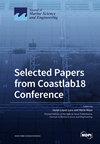球藻不同形态细胞对紫外线-B 辐射的反应
IF 2.8
3区 地球科学
Q1 ENGINEERING, MARINE
引用次数: 0
摘要
球囊藻是浮游生物群落中的重要成员,被认为是一种典型的水华形成藻类。它的生命周期多变,包括单细胞和群体细胞。球囊藻的生长过程易受紫外线-B 辐射的影响。然而,紫外线-B 对光合作用活性的影响以及由此导致的细胞程序性死亡(PCD)过程还不完全清楚。我们的研究结果表明,经紫外线-B 处理后,单细胞和集落细胞的 Fv/Fm、rETRmax、Y(II) 和 α 均显著下降(p < 0.05)。与单细胞相比,集落细胞的损伤率更低,修复率更高(p < 0.05),这表明集落细胞具有更好的抗紫外线-B 辐射能力。紫外线-B 辐射后,我们发现两种细胞形态中都出现了 PCD 的特征性标记--磷脂酰丝氨酸(PS)外化和 DNA 断裂,同时类 Caspase-3 活性增加,证明 PCD 已经开始。此外,还检测了活性氧(ROS)含量和抗氧化酶活性。结果显示,在紫外线-B 辐射下,ROS 含量上升,单细胞明显高于集落细胞(p < 0.001)。此外,超氧化物歧化酶(SOD)和过氧化氢酶(CAT)的活性也有所提高,单个细胞的活性始终明显高于群体细胞(p < 0.05),但 ROS 含量的变化趋势与 CAT 和 SOD 活性的变化趋势并不一致。这可能是由于单个细胞坏死造成的。研究结果表明,在紫外线-B 辐射下,除了 PCD 外,孤岛细胞也会发生坏死。这项研究证明,海洋微藻的不同形态细胞对紫外线-B 辐射有不同的反应。该研究有助于进一步了解球藻的环境适应机制。本文章由计算机程序翻译,如有差异,请以英文原文为准。
Responses of Different Morphological Cells of Phaeocystis globosa to UV-B Radiation
Phaeocystis globosa is an important member of the plankton community and was considered to be a typical bloom-forming algae. Its life cycle is variable, comprising both solitary and colony cells. The growth process of P. globosa is vulnerable to UV-B radiation. However, the influence of UV-B on photosynthetic activity and the resulting programmed cell death (PCD) process is not entirely understood. Our findings demonstrated that Fv/Fm, rETRmax, Y(II) and α of solitary and colony cells were significantly decreased after UV-B treatment (p < 0.05). The colony cells showed a lower damage rate and higher repair rate than solitary cells (p < 0.05), suggesting that colony cells have better UV-B radiation resistance. After UV-B radiation, we found the characteristic markers of PCD-phosphatidylserine (PS) externalization and DNA fragmentation were discovered in the two cell morphologies, with increased caspase-3-like activity, proving the onset of PCD. In addition, the reactive oxygen species (ROS) content and antioxidant enzyme activities were examined. The results showed that, the ROS content went up, the solitary cells were significantly greater than colony cells under UV-B radiation (p < 0.001). In addition, the superoxide dismutase (SOD) and catalase (CAT) activities increased, and solitary cells always had significantly higher activity than colony cells (p < 0.05), but the changing trend in ROS content did not match the changes in CAT and SOD activities. This may have been due to the necrosis of solitary cells. The findings show that, besides PCD, solitary cells also developed necrosis under UV-B radiation. This study provides evidence that different morphological cells of marine microalgae present different reactions to UV-B radiation. It helps to further improve the knowledge of the environmental adaptation mechanism of P. globosa.
求助全文
通过发布文献求助,成功后即可免费获取论文全文。
去求助
来源期刊

Journal of Marine Science and Engineering
Engineering-Ocean Engineering
CiteScore
4.40
自引率
20.70%
发文量
1640
审稿时长
18.09 days
期刊介绍:
Journal of Marine Science and Engineering (JMSE; ISSN 2077-1312) is an international, peer-reviewed open access journal which provides an advanced forum for studies related to marine science and engineering. It publishes reviews, research papers and communications. Our aim is to encourage scientists to publish their experimental and theoretical results in as much detail as possible. There is no restriction on the length of the papers. The full experimental details must be provided so that the results can be reproduced. Electronic files and software regarding the full details of the calculation or experimental procedure, if unable to be published in a normal way, can be deposited as supplementary electronic material.
 求助内容:
求助内容: 应助结果提醒方式:
应助结果提醒方式:


